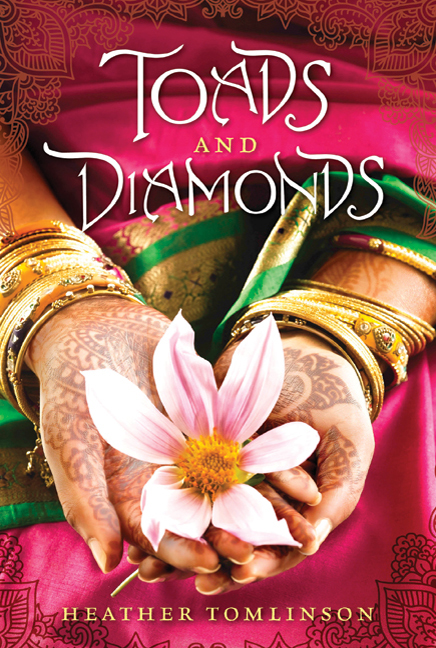Toads and Diamonds
 In preparation for the upcoming NaNoWriMo, I've been particularly interested with a more Arabian and Indian slant to fairy tale and folklore. Of course, I wouldn't dismiss the western classics so easily. I picked Toads and Diamonds up at the library because Heather Tomlinson promised to do a particular blending of west and east. And boy did she remind me why I loved retellings.
In preparation for the upcoming NaNoWriMo, I've been particularly interested with a more Arabian and Indian slant to fairy tale and folklore. Of course, I wouldn't dismiss the western classics so easily. I picked Toads and Diamonds up at the library because Heather Tomlinson promised to do a particular blending of west and east. And boy did she remind me why I loved retellings.
First, the inspiration: Charles Perrault's "Toads and Diamonds" tells the story of two sisters, one good, one evil (as a number of fairy tales tend to do). When the kind and beautiful sister is sent to fetch water from the well, she encounters a fairy dressed as an old woman. The fairy begs for help in retrieving water from the well, the good sister acquiesces. Thus, the fairy gifts the good sister with the ability to conjure gems and flowers through the powers of speech. Likewise, out goes the bad sister. This time, however, the fairy is dressed as a noblewoman asking for water. Sharp and shrewish, the bad sister refuses to help, and the fairy curses the bad sister with toads and snakes through speech.
It's a simple moral tale.
But what if both sisters were not necessarily "bad"? And what if the conjuring of toads and snakes is considered a blessing to a country filled with infestation and plague?
Tomlinson's Toads and Diamonds addresses a world similar to an ancient Indian empire. Diribani and Tana are sisters with different skills; Diribani is the pretty, kind, and benevolent one, whilst Tana is the clever, graceful, and practical one. Both sisters make ends meet by selling their deceased father's jewels, and both work hard to support themselves and their mother. When Diribani goes out to fetch water, she meets the goddess Nagali-ji, and becomes gifted with flowers and gems. When Tana goes out to fetch water, she also meets the same goddess, and she becomes gifted with snakes and toads.
As a result, Diribani's miracle wealth attracts the attention of the prince and the province's greedy governor, resulting in her journey out of the province in order to save her life. Tana, on the other hand, is chased out of her home, for the governor is afraid of snakes, though many in the village consider these animals to be blessings. The story alternates between the viewpoints of the two sisters, both of whom struggle to understand the full meaning of Nagali-ji's gifts.
Both sisters were fantastic. Out of preference, I favored Tana over Diribani, however, this didn't stop me from cheering both on in their respective scenes. The pacing on the chapters were quick and smoothly done, though I did grumble at the end of the cliffhanger chapters, because then I had to wait to read what happens a chapter later.
That said, I wish there was more written of the other characters! The romances I felt were hurried and weren't fully conclusive. There was also the matter of Kalyan's plea with the emperor, and then the problem with the emperor's eldest son. And what about Ruqqaya? I think she was probably the most fascinating character in the story, and honestly, so much more could have been done about other plot points. There were certainly enough open-ended possibilities to get another story going!
So yes, kudos on the multicultural storytelling going on here, and the fantastic characters.






